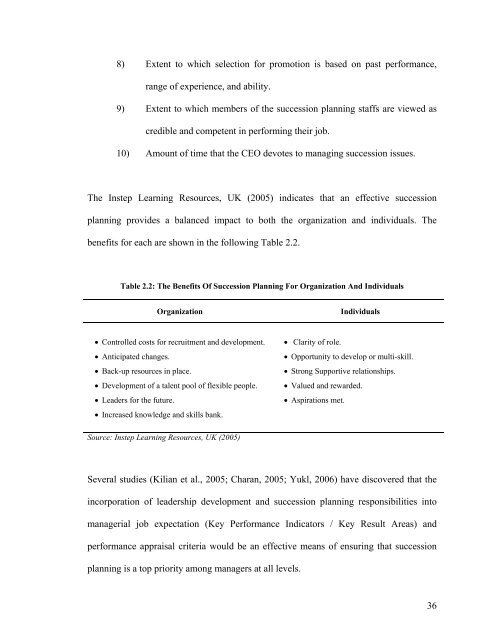CHAPTER 1: INTRODUCTION 1.0 Chapter Overview - DSpace@UM
CHAPTER 1: INTRODUCTION 1.0 Chapter Overview - DSpace@UM
CHAPTER 1: INTRODUCTION 1.0 Chapter Overview - DSpace@UM
You also want an ePaper? Increase the reach of your titles
YUMPU automatically turns print PDFs into web optimized ePapers that Google loves.
8) Extent to which selection for promotion is based on past performance,range of experience, and ability.9) Extent to which members of the succession planning staffs are viewed ascredible and competent in performing their job.10) Amount of time that the CEO devotes to managing succession issues.The Instep Learning Resources, UK (2005) indicates that an effective successionplanning provides a balanced impact to both the organization and individuals. Thebenefits for each are shown in the following Table 2.2.Table 2.2: The Benefits Of Succession Planning For Organization And IndividualsOrganizationIndividuals• Controlled costs for recruitment and development.• Anticipated changes.• Back-up resources in place.• Development of a talent pool of flexible people.• Leaders for the future.• Increased knowledge and skills bank.• Clarity of role.• Opportunity to develop or multi-skill.• Strong Supportive relationships.• Valued and rewarded.• Aspirations met.Source: Instep Learning Resources, UK (2005)Several studies (Kilian et al., 2005; Charan, 2005; Yukl, 2006) have discovered that theincorporation of leadership development and succession planning responsibilities intomanagerial job expectation (Key Performance Indicators / Key Result Areas) andperformance appraisal criteria would be an effective means of ensuring that successionplanning is a top priority among managers at all levels.36
















